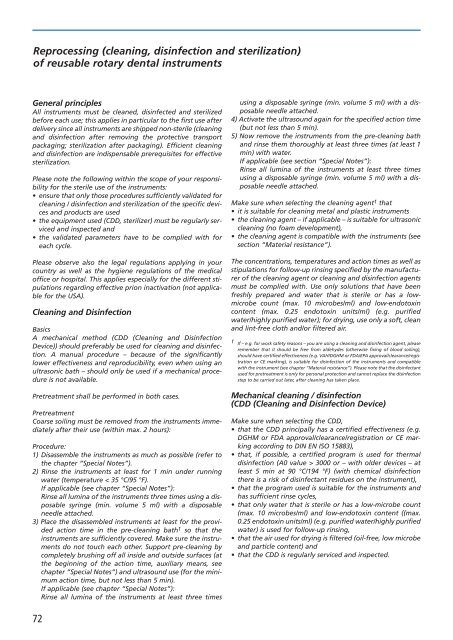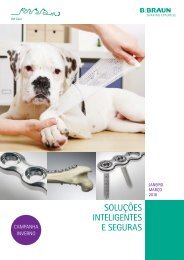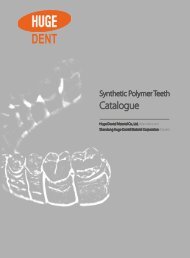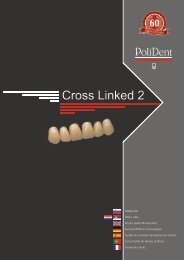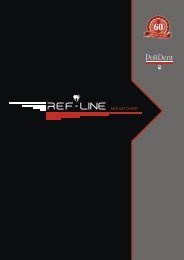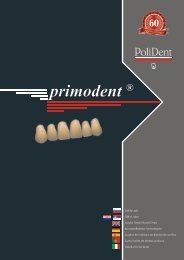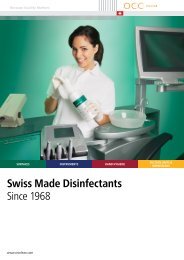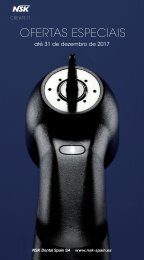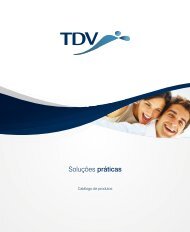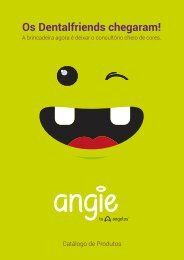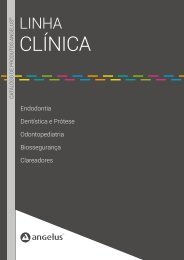Dentistry DE_US 2017 x4
You also want an ePaper? Increase the reach of your titles
YUMPU automatically turns print PDFs into web optimized ePapers that Google loves.
Reprocessing (cleaning, disinfection and sterilization)<br />
of reusable rotary dental instruments<br />
General principles<br />
All instruments must be cleaned, disinfected and sterilized<br />
before each use; this applies in particular to the first use after<br />
delivery since all instruments are shipped non-sterile (cleaning<br />
and disinfection after removing the protective transport<br />
packaging; sterilization after packaging). Efficient cleaning<br />
and disinfection are indispensable prerequisites for effective<br />
sterilization.<br />
Please note the following within the scope of your responsibility<br />
for the sterile use of the instruments:<br />
• ensure that only those procedures sufficiently validated for<br />
cleaning / disinfection and sterilization of the specific devices<br />
and products are used<br />
• the equipment used (CDD, sterilizer) must be regularly serviced<br />
and inspected and<br />
• the validated parameters have to be complied with for<br />
each cycle.<br />
Please observe also the legal regulations applying in your<br />
country as well as the hygiene regulations of the medical<br />
office or hospital. This applies especially for the different stipulations<br />
regarding effective prion inactivation (not applicable<br />
for the <strong>US</strong>A).<br />
Cleaning and Disinfection<br />
Basics<br />
A mechanical method (CDD (Cleaning and Disinfection<br />
Device)) should preferably be used for cleaning and disinfection.<br />
A manual procedure – because of the significantly<br />
lower effectiveness and reproducibility, even when using an<br />
ultrasonic bath – should only be used if a mechanical procedure<br />
is not available.<br />
Pretreatment shall be performed in both cases.<br />
Pretreatment<br />
Coarse soiling must be removed from the instruments immediately<br />
after their use (within max. 2 hours):<br />
Procedure:<br />
1) Disassemble the instruments as much as possible (refer to<br />
the chapter “Special Notes”).<br />
2) Rinse the instruments at least for 1 min under running<br />
water (temperature < 35 °C/95 °F).<br />
If applicable (see chapter “Special Notes”):<br />
Rinse all lumina of the instruments three times using a disposable<br />
syringe (min. volume 5 ml) with a disposable<br />
needle attached.<br />
3) Place the disassembled instruments at least for the provided<br />
action time in the pre-cleaning bath 1 so that the<br />
instruments are sufficiently covered. Make sure the instruments<br />
do not touch each other. Support pre-cleaning by<br />
completely brushing off all inside and outside surfaces (at<br />
the beginning of the action time, auxiliary means, see<br />
chapter “Special Notes”) and ultrasound use (for the minimum<br />
action time, but not less than 5 min).<br />
If applicable (see chapter “Special Notes”):<br />
Rinse all lumina of the instruments at least three times<br />
using a disposable syringe (min. volume 5 ml) with a disposable<br />
needle attached.<br />
4) Activate the ultrasound again for the specified action time<br />
(but not less than 5 min).<br />
5) Now remove the instruments from the pre-cleaning bath<br />
and rinse them thoroughly at least three times (at least 1<br />
min) with water.<br />
If applicable (see section “Special Notes”):<br />
Rinse all lumina of the instruments at least three times<br />
using a disposable syringe (min. volume 5 ml) with a disposable<br />
needle attached.<br />
Make sure when selecting the cleaning agent 1 that<br />
• it is suitable for cleaning metal and plastic instruments<br />
• the cleaning agent – if applicable – is suitable for ultrasonic<br />
cleaning (no foam development),<br />
• the cleaning agent is compatible with the instruments (see<br />
section “Material resistance”).<br />
The concentrations, temperatures and action times as well as<br />
stipulations for follow-up rinsing specified by the manufacturer<br />
of the cleaning agent or cleaning and disinfection agents<br />
must be complied with. Use only solutions that have been<br />
freshly prepared and water that is sterile or has a lowmicrobe<br />
count (max. 10 microbes/ml) and low-endotoxin<br />
content (max. 0.25 endotoxin units/ml) (e.g. purified<br />
water/highly purified water); for drying, use only a soft, clean<br />
and lint-free cloth and/or filtered air.<br />
1 If – e.g. for work safety reasons – you are using a cleaning and disinfection agent, please<br />
remember that it should be free from aldehydes (otherwise fixing of blood soiling),<br />
should have certified effectiveness (e.g. VAH/DGHM or FDA/EPA approval/clearance/registration<br />
or CE marking), is suitable for disinfection of the instruments and compatible<br />
with the instrument (see chapter “Material resistance”). Please note that the disinfectant<br />
used for pretreatment is only for personal protection and cannot replace the disinfection<br />
step to be carried out later, after cleaning has taken place.<br />
Mechanical cleaning / disinfection<br />
(CDD (Cleaning and Disinfection Device)<br />
Make sure when selecting the CDD,<br />
• that the CDD principally has a certified effectiveness (e.g.<br />
DGHM or FDA approval/clearance/registration or CE marking<br />
according to DIN EN ISO 15883),<br />
• that, if possible, a certified program is used for thermal<br />
disinfection (A0 value > 3000 or – with older devices – at<br />
least 5 min at 90 °C/194 °F) (with chemical disinfection<br />
there is a risk of disinfectant residues on the instrument),<br />
• that the program used is suitable for the instruments and<br />
has sufficient rinse cycles,<br />
• that only water that is sterile or has a low-microbe count<br />
(max. 10 microbes/ml) and low-endotoxin content ((max.<br />
0.25 endotoxin units/ml) (e.g. purified water/highly purified<br />
water) is used for follow-up rinsing,<br />
• that the air used for drying is filtered (oil-free, low microbe<br />
and particle content) and<br />
• that the CDD is regularly serviced and inspected.<br />
72


